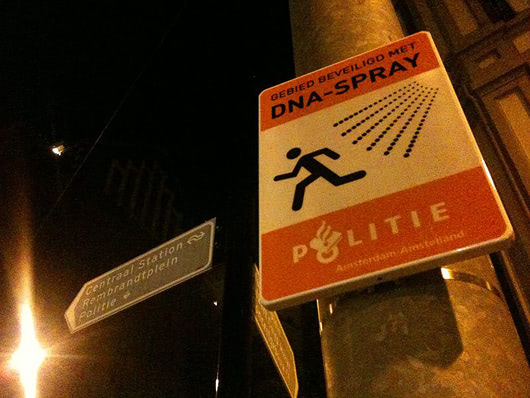I've noticed DNA spray notices springing up around Amsterdam. I assumed it was a fairly standard anti-theft device: A crime is committed, a little nozzle is activated by the offended shop owner, and the criminal is coated in a long-lasting UV-dye. So far, a more advanced update of the standard 'exploding ink in a wad of money' trick, but nothing unusual. The DNA angle seemed like a marketing ploy to make a banal technology sound bio-futuristic.
It turns out that the dye actually does contain synthetic DNA unique to each location. The company is a bit cagey is to the exact composition of their 'DNA solution,' assuring customers only that it contains all relevant information and is 100% non-toxic. The genome may be synthetic, but if it is composed of a double-helix polymer made of nucleotides, then it is certainly not fake.
Here, the DNA does not code for a living organism. It codes for an event (the crime), and it codes for a location. We often talk of neighborhoods having a personality, or of cities having a character. DNA spray pushes the urban environment one step towards actual personhood. Particularly enterprising thieves will mix the genetic material, bumblebee-like, and encode for as-yet-built locations. Future crime-prevention tech may create bespoke infections that produce flamboyant symptoms, or custom parasites that make crooks fond of truth-telling and police stations.

Arnoud van den Heuvel
Anti DNA-SPRAY device: <img src="https://nextnature.net/wp-content/uploads/2011/02/dna_spray_umbrella.jpg" width="300" height="300"/>
Posted on
Dorian Taylor
I wonder how one would handle false positives from coming in contact with the spray. Wouldn't that on its own be reasonable doubt?
Posted on